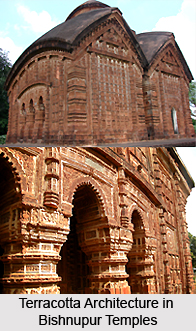 Bishnupur is a city and municipality in the Bankura District, West Bengal. The architectural panorama of Bishnupur encompasses thirty Hindu temples that are decorated with terracotta and the rest are a treasure-trove of terracotta sculptures. Lord Krishna, an incarnation of Vishnu and his love Radha, are deified in most of these temples. The temples of Bishnupur are divided into three groups namely the northern group, the middle group and the southern group of temples. The history of Bishnupur dates back to the Gupta period when it was under the dominion of the Hindu kings. It was also the capital of the Malla dynasty. The Malla rulers were the followers of Lord Vishnu and constructed many famous terracotta temples during the 17th and 18th century at this place. The terracotta temples here are the best example of the classical style of Bengal architecture. In the 18th century they fought against the Marathas and in the year 1806, the East India Company took over the reign of the place.
Bishnupur is a city and municipality in the Bankura District, West Bengal. The architectural panorama of Bishnupur encompasses thirty Hindu temples that are decorated with terracotta and the rest are a treasure-trove of terracotta sculptures. Lord Krishna, an incarnation of Vishnu and his love Radha, are deified in most of these temples. The temples of Bishnupur are divided into three groups namely the northern group, the middle group and the southern group of temples. The history of Bishnupur dates back to the Gupta period when it was under the dominion of the Hindu kings. It was also the capital of the Malla dynasty. The Malla rulers were the followers of Lord Vishnu and constructed many famous terracotta temples during the 17th and 18th century at this place. The terracotta temples here are the best example of the classical style of Bengal architecture. In the 18th century they fought against the Marathas and in the year 1806, the East India Company took over the reign of the place.
The architecture of the temples speaks volumes of the exquisite craftsmanship of the artisans of the region. Among the northern group of temples the Murali Mohana temple has a small, shikhara type tower called Eka Ratna which is quite different from other temples, as walls surround the first floor and it has a pillared corridor on all four sides. This type of open pathway is rare in Bengali temples. The Madana Mohana temple is dedicated to the patron God of the Malla dynasty, Madana Mohana or Krishna. The walls of the brick temple are decorated with terracotta sculptures which are mostly legends of Lord Krishna. The parapet on the roof and the arches reflect an architectural influence of Islam.
The Rasa Mancha temple belongs to the middle group of temples in Bishnupur. This temple is quite unique in its structural design. It has a cubic shrine, pillared corridors on three sides and a pyramidal roof. The Radha Shyama temple was constructed in the later period of the Malla dynasty. Its Eka Ratna tower is not tiered but is more like an Islamic dome. It is a laterite structure, finished with stucco. The stucco has sculptures like those on terracotta panels. The best creations of the terracotta architecture are the Radha Shyama Temple along with the Keshta Raya Temple. The Keshta Raya temple has two traditional Bengali houses placed together and the sloping split roof is called the Bengaldar roof. This architecture of the roof was later adopted by the Mughals and the Rajputs. The Shyama Raya temple is built of bricks. The exterior and interior are clad with high quality, densely sculpted, terracotta panels. The temple has a square plan with porches on all four sides and a three-arch entrance, on each of the four sides. It reflects a heavy Islamic influence, but it also reflects, the complex construction methodology followed in India for the different styled towers. Most of the sculptures are of Krishna and are Rasa mandates with Krishna, Radha and Krishna`s gopinis. The ceiling is an Islamic dome with a terracotta finish that is not seen in any other temple.
On the southern outskirts are seven temples made of laterite and not brick. The most popular Eka Ratna temples of Bishnupur are all made of laterite. The Jora mandir is a group of three temples in the front and another temple at the back. All four temples have the same facade, on all four sides. Tales from the Ramayana are sculpted on the laterite walls of these temples. The Kalachand temple is an Eka Ratna temple of a very early period. The eaves of the lower tier clearly show that wood has been used for its construction. The Radha Govinda temple has stone wheels that have been attached to the low platform. The architectural style of the building is done in such a way that it resembles the chariot in which Krishna took Arjuna to war in the Mahabharata.
Thus, the architecture of Bishnupur reveals a rich heritage of the Indian architecture. The terracotta temples built under the patronage of the Malla kings are the most striking features in this region.




